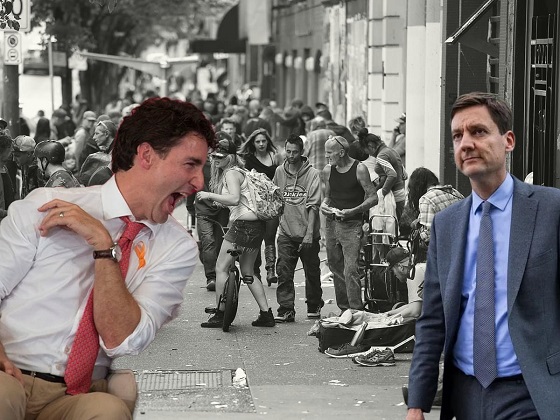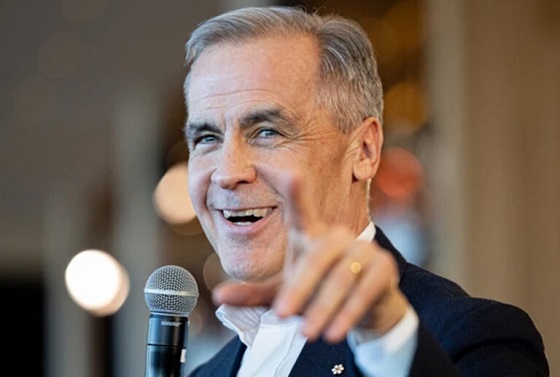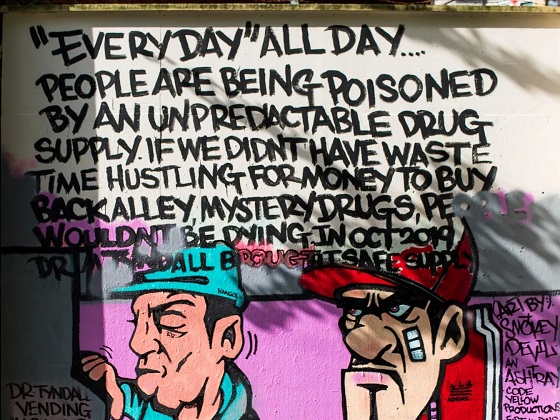Opinion
Fentanyl Fiasco: The Tragic Missteps of BC’s Drug Policy

From The Opposition News Network
|
|
Unmasking the Destructive Cycle of Drug Policy in British Columbia. A Tale of Good Intentions and Dire Consequences
My fellow Canadians, it’s been a challenging time. I had initially planned to bring you the latest spectacle from the House of Commons, featuring Kristian Firth, but fate had other plans. A personal emergency struck closer to home—a fentanyl overdose in the family. This tragic event threw us headlong into the chaotic circus that is the British Columbia health system. Let me be frank: the system is a mockery. The privacy laws that supposedly protect us also shroud our crises in unnecessary mystery. When my uncle was found unconscious and rushed to the ICU, the walls of confidentiality meant we could not even ascertain his condition over the phone. They notify you of the disaster but cloak its nature in secrecy. It’s an absurdity that only adds to the anguish of families grappling with the realities of addiction.
Now, let’s address the elephant in the room: our approach to drug addiction. The authorities label it a disease, yet paradoxically offer the afflicted the choice between seeking help and remaining in their dire state. This half-hearted stance on drug addiction only perpetuates a cycle of relapse and despair. As we speak, thousands tumble through the revolving doors of our medical facilities—5,975 apparent opioid toxicity deaths this year alone, an 8% increase from 2022. Daily, we see 22 deaths and 17 hospitalizations, and yet our response remains as ineffective as ever. This issue transcends our national borders. The U.S. has openly criticized China for its role in the opioid crisis, accusing it of flooding North America with fentanyl—a drug so potent, it’s decimating communities at an unprecedented rate. Just last year, over 70,000 Americans succumbed to fentanyl overdoses. And what’s more damning? Reports from U.S. congressional committees suggest that the Chinese government might be subsidizing firms that traffic these lethal substances. Lets be clear this is a state-sponsored assault on our populace.
In response to this crisis BC NDP policymakers have championed the notion of “safe supply” programs. These initiatives distribute free hydromorphone, a potent opioid akin to heroin, with the intention of steering users away from the perils of contaminated street drugs. At first glance, this approach might seem logical, even humane. However, the grim realities paint a far different picture, one where good intentions pave the road to societal decay. Addiction specialists are sounding the alarm, and the news isn’t good. While hydromorphone is potent, it lacks the intensity to satisfy fentanyl users, leading to an unintended consequence: diversion. Users, unappeased by the drug’s effects, are selling their “safe” supply on the black market. This results in a glut of hydromorphone flooding the streets, crashing its price by up to 95% in certain areas. This collapse in street value might seem like a win for economic textbooks, but in the harsh world of drug abuse, it’s a catalyst for disaster. Cheap, readily available opioids are finding their way into the hands of an ever-younger audience, ensnaring teenagers in the grips of addiction. Far from reducing harm, these programs are inadvertently setting the stage for a new wave of drug dependency among our most vulnerable.
Programs designed to save lives are instead spinning a web of addiction that ensnares not just existing drug users but also initiates unsuspecting adolescents into a life of dependency. What’s needed isn’t more drugs, even under the guise of medical oversight, but a robust support system that addresses the root causes of addiction yet, the stark reality on the streets tells a story of systemic failure. Let’s dissect the current approach to handling addiction, a condition deeply intertwined with our societal, legal, and health systems.
Take a typical scenario—an individual battling the throes of addiction. Many of them find themselves ensnared by the law, often for crimes like theft, driven by the desperate need to sustain their habit. Yes, many addicts find themselves behind bars, where, paradoxically, they claim to clean up. Jail, devoid of freedom, ironically becomes a place of forced sobriety.
Now, consider the next step in this cycle: release. Upon their release, these individuals, now momentarily clean, are promised treatment—real help, real change. Yet, here’s the catch: this promised help is dangled like a carrot on a stick, often 30 or more days away. What happens in those 30 days? Left to their own devices, many relapse, falling back into old patterns before they ever step foot in a treatment facility.
This brings us to a critical question: why release an individual who has begun to detox in a controlled environment, only to thrust them back into the very conditions that fueled their addiction? Why not maintain custody until a treatment spot opens up? From a fiscal perspective, this dance of incarceration, release, and delayed treatment is an exercise in futility, burning through public funds without solving the core issue. Moreover, from a standpoint of basic human decency and dignity, this system is profoundly flawed. We play roulette with lives on the line, hoping against odds for a favorable outcome when we already hold a losing hand. This isn’t just ineffective; it’s cruel.
Final Thoughts
As we close the curtain on this discussion, let’s not mince words. The BC system’s approach to drug addiction treatment isn’t just flawed; it’s a catastrophic failure masquerading as mercy. Opposition leader Pierre Poilievre has hit the nail squarely on the head in his piece for the National Post. He articulates a vision where compassion and practicality intersect, not through the failed policies of perpetual maintenance, but through genuine, recovery-oriented solutions. His stance is clear: treat addiction as the profound health crisis it is, not as a criminal issue to be swept under the rug of incarceration.
Contrast this with the so-called ‘safe supply’ madness—a Band-Aid solution to a hemorrhaging societal wound. In the dystopian theatre of the Downtown Eastside, where welfare checks and drug dens operate with the efficiency of a grotesque assembly line, what we see is not healthcare, but a deathcare system. It’s a cycle of despair that offers a needle in one hand and a shot of naloxone in the other as a safety net. This isn’t treatment; it’s a perverse form of life support that keeps the heart beating but lets the soul wither.
Come next election in BC, if any provincial party is prepared to advocate for a true treatment-first approach, to shift from enabling addiction to empowering recovery, they will have my—and should have your—unwavering support. We must champion platforms that prioritize recovery, that respect human dignity, and that restore hope to the heartbroken streets of our communities.
The NDP BC government’s current model perpetuates death and decay under the guise of progressive policy. It’s a cruel joke on the citizens who need help the most. We can no longer afford to stand idly by as lives are lost to a system that confuses sustaining addiction with saving lives. Let’s rally for change, for recovery, for a future where Canadians struggling with addiction are given a real shot at redemption. This isn’t just a political imperative—it’s a moral one. The time for half-measures is over. The time for real action is now.
Become a supporter of The Opposition with Dan Knight .
For the full experience, click here to upgrade your subscription.
2025 Federal Election
The Cost of Underselling Canadian Oil and Gas to the USA

From the Frontier Centre for Public Policy
Canadians can now track in real time how much revenue the country is forfeiting to the United States by selling its oil at discounted prices, thanks to a new online tracker from the Frontier Centre for Public Policy. The tracker shows the billions in revenue lost due to limited access to distribution for Canadian oil.
At a time of economic troubles and commercial tensions with the United States, selling our oil at a discount to U.S. middlemen who then sell it in the open markets at full price will rob Canada of nearly $19 billion this year, said Marco Navarro-Genie, the VP of Research at the Frontier Centre for Public Policy.
Navarro-Genie led the team that designed the counter.
The gap between world market prices and what Canada receives is due to the lack of Canadian infrastructure.
According to a recent analysis by Ian Madsen, senior policy analyst at the Frontier Centre, the lack of international export options forces Canadian producers to accept prices far below the world average. Each day this continues, the country loses hundreds of millions in potential revenue. This is a problem with a straightforward remedy, said David Leis, the Centre’s President. More pipelines need to be approved and built.
While the Trans Mountain Expansion (TMX) pipeline has helped, more is needed. It commenced commercial operations on May 1, 2024, nearly tripling Canada’s oil export capacity westward from 300,000 to 890,000 barrels daily. This expansion gives Canadian oil producers access to broader global markets, including Asia and the U.S. West Coast, potentially reducing the price discount on Canadian crude.
This is more than an oil story. While our oil price differential has long been recognized, there’s growing urgency around our natural gas exports. The global demand for cleaner energy, including Canadian natural gas, is climbing. Canada exports an average of 12.3 million GJ of gas daily. Yet, we can still not get the full value due to infrastructure bottlenecks, with losses of over $7.3 billion (2024). A dedicated counter reflecting these mounting gas losses underscores how critical this issue is.
“The losses are not theoretical numbers,” said Madsen. “This is real money, and Canadians can now see it slipping away, second by second.”
The Frontier Centre urges policymakers and industry leaders to recognize the economic urgency and ensure that infrastructure projects like TMX are fully supported and efficiently utilized to maximize Canada’s oil export potential. The webpage hosting the counter offers several examples of what the lost revenue could buy for Canadians. A similar counter for gas revenue lost through similarly discounted gas exports will be added in the coming days.
What Could Canada Do With $25.6 Billion a Year?
Without greater pipeline capacity, Canada loses an estimated (2025) $25.6 billion by selling our oil and gas to the U.S. at a steep discount. That money could be used in our communities — funding national defence, hiring nurses, supporting seniors, building schools, and improving infrastructure. Here’s what we’re giving up by underselling these natural resources.

342,000 Nurses
The average annual salary for a registered nurse in Canada is about $74,958. These funds could address staffing shortages and improve patient care nationwide.
Source

39,000 New Housing Units
At an estimated $472,000 per unit (excluding land costs, based on Toronto averages), $25.6 billion could fund nearly 94,000 affordable housing units.
Source
About the Frontier Centre for Public Policy
The Frontier Centre for Public Policy is an independent Canadian think-tank that researches and analyzes public policy issues, including energy, economics and governance.
Automotive
Hyundai moves SUV production to U.S.

 MxM News
MxM News
Quick Hit:
Hyundai is responding swiftly to 47th President Donald Trump’s newly implemented auto tariffs by shifting key vehicle production from Mexico to the U.S. The automaker, heavily reliant on the American market, has formed a specialized task force and committed billions to American manufacturing, highlighting how Trump’s America First economic policies are already impacting global business decisions.
Key Details:
-
Hyundai has created a tariffs task force and is relocating Tucson SUV production from Mexico to Alabama.
-
Despite a 25% tariff on car imports that began April 3, Hyundai reported a 2% gain in Q1 operating profit and maintained earnings guidance.
-
Hyundai and Kia derive one-third of their global sales from the U.S., where two-thirds of their vehicles are imported.
Diving Deeper:
In a direct response to President Trump’s decisive new tariffs on imported automobiles, Hyundai announced Thursday it has mobilized a specialized task force to mitigate the financial impact of the new trade policy and confirmed production shifts of one of its top-selling models to the United States. The move underscores the gravity of the new 25% import tax and the economic leverage wielded by a White House that is now unambiguously prioritizing American industry.
Starting with its popular Tucson SUV, Hyundai is transitioning some manufacturing from Mexico to its Alabama facility. Additional consideration is being given to relocating production away from Seoul for other U.S.-bound vehicles, signaling that the company is bracing for the long-term implications of Trump’s tariffs.
This move comes as the 25% import tax on vehicles went into effect April 3, with a matching tariff on auto parts scheduled to hit May 3. Hyundai, which generates a full third of its global revenue from American consumers, knows it can’t afford to delay action. Notably, U.S. retail sales for Hyundai jumped 11% last quarter, as car buyers rushed to purchase vehicles before prices inevitably climb due to the tariff.
Despite the trade policy, Hyundai reported a 2% uptick in first-quarter operating profit and reaffirmed its earnings projections, indicating confidence in its ability to adapt. Yet the company isn’t taking chances. Ahead of the tariffs, Hyundai stockpiled over three months of inventory in U.S. markets, hoping to blunt the initial shock of the increased import costs.
In a significant show of good faith and commitment to U.S. manufacturing, Hyundai last month pledged a massive $21 billion investment into its new Georgia plant. That announcement was made during a visit to the White House, just days before President Trump unveiled the auto tariff policy — a strategic alignment with a pro-growth, pro-America agenda.
Still, the challenges are substantial. The global auto industry depends on complex, multi-country supply chains, and analysts warn that tariffs will force production costs higher. Hyundai is holding the line on pricing for now, promising to keep current model prices stable through June 2. After that, however, price adjustments are on the table, potentially passing the burden to consumers.
South Korea, which remains one of the largest exporters of automobiles to the U.S., is not standing idle. A South Korean delegation is scheduled to meet with U.S. trade officials in Washington Thursday, marking the start of negotiations that could redefine the two nations’ trade dynamics.
President Trump’s actions represent a sharp pivot from the era of global corporatism that defined trade under the Obama-Biden administration. Hyundai’s swift response proves that when the U.S. government puts its market power to work, foreign companies will move mountains — or at least entire assembly lines — to stay in the game.
-

 Business2 days ago
Business2 days agoIs Government Inflation Reporting Accurate?
-

 2025 Federal Election2 days ago
2025 Federal Election2 days agoCarney’s Hidden Climate Finance Agenda
-

 2025 Federal Election2 days ago
2025 Federal Election2 days agoWhen it comes to pipelines, Carney’s words flow both ways
-

 2025 Federal Election2 days ago
2025 Federal Election2 days agoStudy links B.C.’s drug policies to more overdoses, but researchers urge caution
-

 2025 Federal Election2 days ago
2025 Federal Election2 days agoPolls say Canadians will give Trump what he wants, a Carney victory.
-

 2025 Federal Election1 day ago
2025 Federal Election1 day agoCarney Liberals pledge to follow ‘gender-based goals analysis’ in all government policy
-

 2025 Federal Election1 day ago
2025 Federal Election1 day agoPoilievre’s Conservatives promise to repeal policy allowing male criminals in female jails
-

 2025 Federal Election1 day ago
2025 Federal Election1 day agoTrump Has Driven Canadians Crazy. This Is How Crazy.





